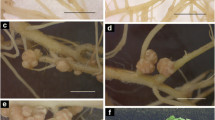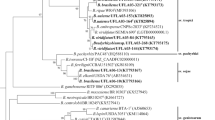Abstract
Two strains of Bradyrhizobium japonicum, recognizable by their intrinsic resistance to high levels of antibiotics and their serological features were introduced into three calcareous soils under field conditions. These strains were re-isolated 16 or 20 years later and compared with the parental strains kept lyophilized. In the Dijon location, the survival was high although soybean was never grown in the field. But the B. japonicum completely disappeared in the Montpellier field after 10 years under vineyard. In the Toulouse field after the two initially introduced strains, inoculation of subsequent soybean crops with a new strain enabled this strain to occupy 70–80% of the nodules; these results suggest that under such conditions the problem of competition can be solved by repeated inoculation. In this field, the number of introduced B. japonicum remained high during 4 years without soybeans, but a new inoculation would be necessary after 5 years. In the two fields where the survival was high, the two strains remained at about the same relative level as at introduction, there was no detectable exchange of characters between them. With regards to agronomic characteristics, there were no important changes in the competitivity of the strains. Among the eight field isolates tested in a greenhouse for efficiency by comparison with eight lyophilized isolates, seven showed no significant difference for the total weight of soybean or seed yield but one field isolate showed a loss of efficiency corresponding to 27% less seed weight. This long-term experiment allowed us to conclude that the B. japonicumstrains used were stable for many characters, but variations in efficiency may rarely occur.
Similar content being viewed by others
References
Amarger N and Lobreau J 1982 Quantitative study of nodulation competitiveness in Rhizobium strains. Appl. Environ. Microbiol. 44, 583-488.
Berg R K, Loynadan T E, Zablotowicz R H and Lieberman M T 1988 Nodule occupancy by introduced Bradyrhizobium japonicum in Iowa soils. Agron. J. 80, 876-881.
Bouniols A, Tancogne M, Merrien A and Blanchet R. 1990 L'alimentation azotée des légumineuses à graines dans l'agriculture française actuelle; exemple du soja. C. R. Acad. Agric. Fr. 76, 109-115.
Brockwell J, Gault R R, Zorin M and Roberts M J 1982 Effect of environmental variables on the competition between inoculum strains and naturalized populations of Rhizobium trifolii for nodulation of Trifoliun subterraneum L. and rhizobia persistence in soil. Aust. J. Agric. Res. 33, 803-815.
Brunel B, Cleyet-Marel J C, Normand P and Bardin R 1988 Stability of Bradyrhizobium japonicum inoculants after introduction into soil. Appl. Environ. Microbiol. 54, 2636-2642.
Brunel B, Boeufgras J M, Bernillon D and Bardin R 1990. Phenotypic drift in Bradyrhizobium japonicum populations after introduction into soils as established by numerical analysis. Microb. Ecol. 19, 163-170.
Brutti L, Rivero E, Cancio Pacheco Basurco J, Nicolas M, Iriarte L, Abbiati N, Ljunggren H and Martensson A 1998 Persistance of Bradyrhizobium japonicum in arable soils in Argentina. Appl. Soil Ecol. 10, 87-94.
Bushby H V A 1982 Ecology. In Nitrogen Fixation. Volume 2: Rhizobium. Ed. W J Broughton. pp 35-75. Oxford University Press, Oxford.
Chatel D L, Greenwood R M and Parker C A 1968 Saprophytic competence as an important character in the selection of Rhizobium for inoculation. In Trans. 9th Int. Cong. Soil Sci. Adelaide. pp 11-65. Int. Soc. Soil Sci. Publisher, Sydney.
Cleyet-Marel J C and Crozat Y 1982 Etude écologique en immunofluorescence de Rhizobium japonicum dans le sol et la rhizosphère. Agronomie 2, 243-248.
Crozat Y. 1983 Caractérisation du pouvoir saprophytic de souches de Rhizobium japonicum dans le sol à l'aide de l'inmmunofluorescence. Thèse: Univ. Lyon I, France. 150 p.
Crozat Y, Cleyet-Marel J C, Giraud J J and Obaton M 1982 Survival rates of Rhizobium japonicum populations introduced into different soils. Soil Biol. Biochem. 14, 401-405.
Dooley J J, Harrison S P, Mytton L R, Dye M, Cresswell A, Scott L and Beeching J R 1993 Phylogenetic grouping and identification of Rhizobium isolates on the basis of Random Amplified Polymorphic DNA profiles. Can. J. Microbiol. 39, 665-673.
Dudman W F 1964 Immunodiffusion analysis of the extracellular soluble antigen of two strains of Rhizobium meliloti. J. Bacteriol. 88, 782-794.
Dunigan E P, Bollich P K, Hutchinson R L, Hicks P M, Zaunbrecher F C, Scott S G and Mowers R P 1984 Introduction and survival of an inoculant strain of Rhizobium japonicum in soil. Agron. J. 76, 463-466.
Eaglesham A R J 1987 The use of intrinsic antibiotic resistance for Rhizobium study. In Symbiotic Nitrogen Fixation Technology. Ed. G H Elkan. pp 185-204. Marcel Dekker, New York and Basel.
Fehr W R, Caviness C E, Burmond D T and Pennington J S 1971 Stages of development descriptions for Soybean, Glycine max. Crop Sci. 27, 953-957.
Fisher R E. and Yates F 1963 Statistical Tables for Biological, Agricultural and Medical Research, 6th Edition. Oliver and Boyd, Edinburgh.
Flores M, Gonzalez V, Pardo M A, Leija A, Martinez E, Romero D, Pinero D, Davila G and Palacios R 1988 Genomic instability in Rhizobium phaseoli. J. Bacteriol. 170, 1191-1196.
Gibson A H 1963 Physical environment and symbiotic nitrogen fixation. I. The effect of root temperature on recently nodulated Trifolium subterraneum L. plants. Aust. J. Biol. Sci. 16, 28-42.
Gibson A H, Demezas D H, Gault R R, Bhuvaneswari T V and Brockwell J 1991 Genetic stability of rhizobia in the field. In The Rhizosphere and Plant Growth. Eds. D L Keister and P B Cregan. pp 141-148. Kluwer Academic Publishers, Dordrecht.
Herridge D F and Roughley R S 1975 Variations in colony characteristics and symbiotic effectiveness of Rhizobium. J. Appl. Bacteriol. 38, 19-27.
Hirsh P R 1996 Population dynamics of indigenous and genetically modified rhizobia in the field. New Phytol. 133, 159-171.
Howle P KW, Shipe E R and Skipper H D 1987 Soybean specificity for Bradyrhizobium japonicum strain 110. Agron. J. 79, 595-598.
Ireland J A and Vincent J M 1968 A quantitative study of commpetition for nodule formation In 9th Int. Congress Soil Sci. Adelaide. pp 85-93. Int. Soc. Soil Sci Publishers, Sydney.
Iswaran V, Graham P M and Jauhri K S 1969 Modified Burton's medium for large scale production of culture of Rhizobium japonicum. Curr. Sci. p. 346.
Klubek P B, Hendrickson L L, Zablotowicz R M, Skwara J E, Varsa E C, Smith S, Islieb T G, Maya J, Valdes M, Dazzo F B, Todd R L and Walgenback D D 1988 Competitiveness of selected Bradyrhizobium japonicum strains in Midwestern USA soils. Soil Sci. Soc. Am. J. 52, 662-666.
Kunding C, Hennecke H and Göttfert M 1993 Correlated physical and genetic map of the Bradyrhizobium japonicum 110 genome. J. Bacteriol. 175, 613-622.
Kuykendall L D and Elkan G H 1976 Bradyrhizobium japonicum derivatives differing in nitrogen-fixing efficiency and carbohydrates utilization. Appl. Environ. Microbiol. 32, 511-519.
Labandera CA and Vincent JM. 1975 Loss of symbioic capacity in commercially useful strains of Rhizobium trifolii. J. Appl. Bacteriol. 39, 209-211.
Lagacherie B, Hugot R and Amarger N 1977 Sélection de souches de Rhizobium japonicum d'après la competitivité pour l'infection. Ann. Agron. 28, 379-389.
McLonghlin T J, Hearn S and Alt S G 1990 Competition for nodule occupancy in introduced Bradyrhizobium japonicum strains in a Wisconsin soil with a low indigenous bradyrhizobia population. Can. J. Microbiol. 36, 839-845.
Miller R H and May S 1991 Legume inoculation: Success an failure. In The rhizosphere and plant growth. Eds D L Keister and P B Gregan. pp 123-124. Kluwer Academic Publishers, Dordrecht.
Obaton M 1971 Utilisation des mutants spontanés résistants aux antibiotiques pour l'étude écologique des Rhizobium. C. R. Acad. Sci. Paris. 272, 2630-2633.
Obaton M and Rollier M 1970 L'inoculation du soja: influence de la qualité de l'inoculum sur le rendement en grain et la richesse en protéine de la récolte. C. R. Acad. Agric. France 1174-1195.
Pinochet X, Arnaud F and Cleyet-Marel J C 1993 Competition for nodule occupancy of introduced Bradyrhizobium japonicum strains SMGS1 in French soils already containing Bradyrhizobium japonicum strain G49. Can. J. Microbiol. 39, 1022-1028.
Revellin C, Pinochet X, Beauclair P and Catroux G. 1996. Influence of soil properties and soybean cropping history on the Bradyrhizobium japonicum population in some French Soils. Eur. J. Soil Sci. 47, 505-510.
Schmidt E L. 1974 Quantitative autecological study of microorganisms in soil by immunofluorescence. Soil Sci. 112, 141-149.
Schofield P R, Gibson A M, Dudman W F and Watson J M 1987 Evidence of genetical exchange and recombination of Rhizobium symbiotic plasmids in a soil population. Appl. Environ. Microbiol. 53, 2942-2947.
Staphorst J L and Strijdom B W 1972 The effect of yeast concentration in media on strains of Rhizobium meliloti. Phytotechnica 4, 29-32.
Streeter J G 1994 Failure of inoculant rhizobia to overcome the dominance of indigenous strains for nodule formation. Can. J. Microbiol. 40, 513-522.
Sullivan J T, Patrick H N, Lowther W L, Scott D B and Ronson C W 1995 Nodulating strains of Rhizobium loti arise through chromosomal symbiotic gen-transfer in the environment. Proc. Natl. Acad. Sci. USA 92, 8985-8989.
Thies J E, Singleton P W and Ben Bolhool R 1991a Influence of the size of indigenous rhizobial populations on establishment and symbiotic performance of introduced rhizobia in field-grown legumes. Appl. Environ. Microbiol. 57, 19-28.
Thies J E, Singleton P W and Ben Bolhool R 1991b Modelling symbiotic performance in introduced rhizobia in the field by use of indices of indigenous population size and nitrogen status on the soil. Appl. Environ. Microbiol. 57, 29-37.
Triplett E W, Albrecht K A and Oplinger E S 1993 Crop rotation effects on population of Bradyrhizobium japonicum and Rhiziobium meliloti. Soil. Biol. Biochem. 25, 781-784.
Van Rensburg H J and Strijdom B W 1985 Effectiveness of Rhizobium strains used as inoculants after their introduction into soil. Appl. Environ. Microbiol. 49, 127-131.
Vidor C. and Miller R M 1980 Relative saprophitic competance of Rhizobium japonicum strains in soil as determined by quantitive fluorescent antibody technique (FA). Soil Biol. Biochem. 12, 483-487.
Vincent J M 1970 A Manual for the Practical Study of Root-Nodule Bacteria. IBP Handbook 15. Blackwell Scientific, Oxford.
Weaver R W and Frederick L R 1974a Effect of inoculum rate on competitive nodulation of Glycine max L. I Greenhouse studies. Agron. J. 66, 229-232.
Weaver R W and Frederick L R 1974b Effect of inoculum rate on competitive nodulation of Glycine max L. II Field studies. Agron. J. 66, 233-236.
Weaver R W and Wright S F 1987 Variability in effectiveness of rhizobia during culture and in nodules. Appl. Environ. Microbiol. 53, 2972-2974.
Young J P W and Wexler M 1988 Sym plasmid and chromosomal genotypes are correlated in field populations of Rhizobium leguminosarum. J. Gen. Microbiol. 134, 2731-2739.
Author information
Authors and Affiliations
Corresponding author
Rights and permissions
About this article
Cite this article
Obaton, M., Bouniols, A., Guillaume Piva et al. Are Bradyrhizobium japonicum stable during a long stay in soil?. Plant and Soil 245, 315–326 (2002). https://doi.org/10.1023/A:1020447928911
Issue Date:
DOI: https://doi.org/10.1023/A:1020447928911




